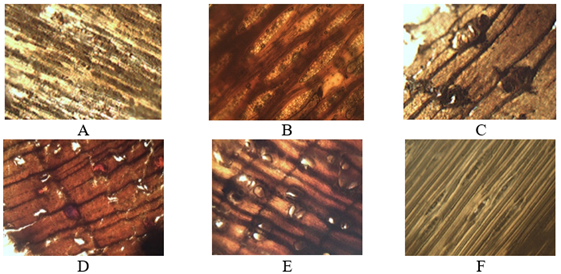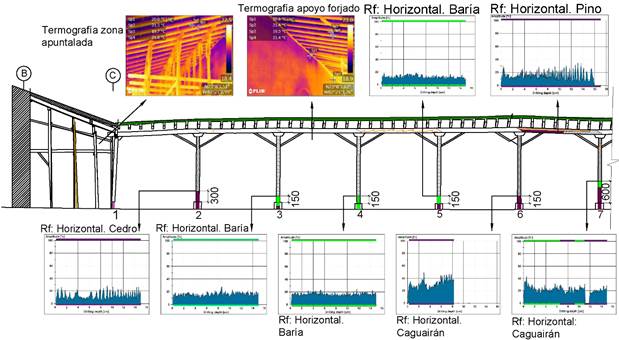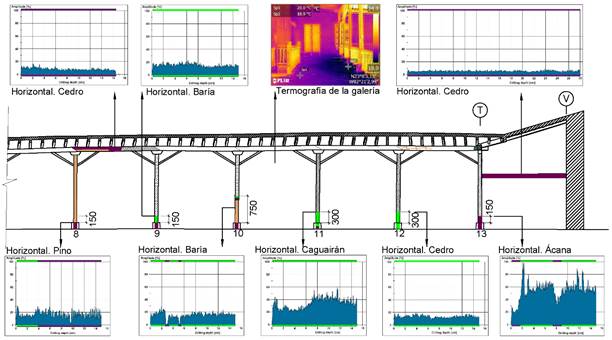| Casos de Estudio | https://doi.org/10.21041/ra.v12i2.584 |
Diagnosis and solutions proposal to the damages present in the ceiling of the Convent of Santa Clara de Asís
Diagnóstico y propuesta de solución a las lesiones presentes en el forjado del Convento de Santa Clara de Asís Diagnóstico e proposta de solução para as lesões presentes na laje do Convento de Santa Clara de Asís
Alberto
Hernández Oroza1
*
![]() ,
Ángela
Diomedes Almeida1
,
Ángela
Diomedes Almeida1
![]() ,
Alina
Romeo Sáez1
,
Alina
Romeo Sáez1
![]() ,
Pedro Ramón
Cuétara Pérez1
,
Pedro Ramón
Cuétara Pérez1
![]()
1 Departamento de Diagnóstico y Levantamiento. Empresa Filial RESTAURA, Oficina del Historiador de La Habana, La Habana Vieja, Cuba.
*Contact author: ahernandez@proyectos.ohc.cu
Reception:
January
11,
2022.
Acceptance:
April
20,
2022.
Publication: May 01, 2022.
| Cite as: Hernández Oroza, A., Diomedes Almeida, A., Romeo Sáez, A., Cuétara Pérez, P. R. (2022), “Diagnosis and solutions proposal to the damages present in the ceiling of the Convent of Santa Clara de Asís”, Revista ALCONPAT, 12 (2), pp. 296 – 310, DOI: https://doi.org/10.21041/ra.v12i2.584 |
Abstract
For the restoration of the wooden ceilings of the Convent of Santa Clara, resistography and penetrometer tests, biological studies of the wood, and geomatic techniques for analysis of deformation and dimensioning of the beams were applied. In the present work, the results of the diagnosis showed that 65% of 98 beams is affected by rot and the presence of xylophagous organisms. Density studies by comparison with reference values, showed a loss in the hardness of the wood. The results conclude in the need to replace 17 beams, and the reinforcement of the wood pillars and sections of sliding beams.
Keywords:
non-destructive testing,
diagnosis,
buildings,
heritage,
geomatics
1. Introduction
The conservation of heritage buildings continues to be one of the most complex problems in the field of construction today. As a consequence of the centuries of exposure, these structures have been subjected to the influence of the effects of climate change and the increase in the atmosphere of corrosive gases (SO2, NOx, O3), leading to an accelerated deterioration of its constituent materials (stone, metal, wood) due to chemical reactions, biological colonization and formation of black crusts (Kherais et al., 2021; Kumar and Imam, 2013; Sesana et al., 2021). This can mean a significant risk to the durability of cultural heritage, which must be duly evaluated by a multidisciplinary work group, supported by different testing techniques, many of which are based on destructive techniques such as extracting of test cores and carrying out coves. However, when dealing with the conservation of the built heritage, this type of invasive studies should be avoided in order to maintain the integrity of the work, its structural elements and, consequently, its heritage value.
Currently there are new non-destructive testing (NDT) techniques that provide information with a high level of precision, accuracy, repeatability and reliability. The applications developed are based on different principles, such as electromagnetic (ultrasound, potential, resistivity), impact (Schmidt hammer, penetrometer), geomatics (laser scanner, photogrammetry), emissive (thermography), among others.
The quantitative analysis obtained from these results during the diagnosis allows identifying the causes of deterioration, evaluating the degree of decay or rotting (Liñán et al., 2011) and then the taking of necessary corrective and conservation actions.
The Convent of Santa Clara de Asís was inaugurated in Havana in 1644, becoming the first religious convent founded in Cuba. In 2018, the Office of the Historian of Havana (OHCH) began a restoration and recovery project that has involved professionals and students from different branches of technical careers, and professionals linked to the field of construction and conservation of built heritage. The results that have been obtained from these investigations allowed the establishment of priorities and methodologies for its gradual intervention and recovery (Guevara et al., 2019).
The objective of this work is to evaluate the state of conservation in the structure of the wooden ceiling of the circulation gallery located on the upper floor of the first cloister, for which a series of NDTs were combined that allowed identifying the pathologies present and determining the magnitude of the injuries in the beams and wood stud that make it up. This implies a proposed solution that is discussed at the end of the work.
2. Case study and methodology
2.1 Identification of the object of study
The structure is located on the upper floor of the first cloister, towards block A (Figure 1). It is based on a wood and plank slab made up of 98 beams of 9 cm x 13 cm (base x height), spaced between 43 cm and 45 cm with an inclination of 17 degrees from the wall towards the wood studs, supported on the 3rd axis on the rammed earth wall that forms the church, and along the axis 4 on a sliding beam that rests on 13 wood studs. The slide beam is made up of 12 beams joined by scarf joint, which rest on the right feet (Table 1). The roof is made up of red ceramic tiles.
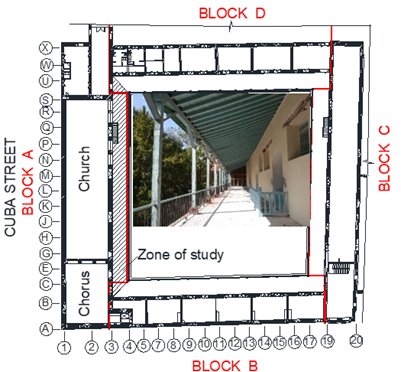 |
||||
| Figure 1. Floor plan sketch of the first cloister, signs and photograph of the gallery studied | ||||
2.2 Analysis and selection of non-destructive tests
The purpose of the NDT is to determine the quality and completeness of the material and its component parts without affecting their properties, functions and usefulness through inspection, measurement or evaluation (Helal et al., 2015; Workman and Moore, 2012). The application of this type of techniques to study the state of conservation of historic buildings has gained validity, mainly due to the advantage of not requiring additional deterioration in the structural elements of the building, to know its state of conservation (Binda and Saisi, 2009; Liñán et al., 2011; Ortega and Ripani, 2007). Due to the fact that wood is an organic material, it is susceptible to degradation processes caused by xylophagous insects, mechanical actions, exposure to weathering, rotting by fungi or the action of fire.
In heritage buildings, the use of NDT adds a high value to the diagnostic study, because the structural elements of wood are not affected or receive a negligible impact. As a result, it is possible to obtain technical information with sufficient precision to estimate the state of conservation, quality and durability of the work or work object studied (Hasníková and Kuklík, 2014; Morales-Conde et al., 2013; Palaia et al., 2008).
The techniques applied were:
2.2.1 Infrared thermography
Infrared thermography is a non-destructive technique that allows pathological analysis through the emission of heat energy by materials. The reading of the radiation emitted in the infrared band makes it possible to interpret the temperature of the material based on the thermal conductivity or the specific heat. Depending on the characteristics and exposure conditions, this material can retain or emit heat. Emissivity is defined by the Stefan-Boltzman Law, which states that radiation is proportional to the temperature of the body and the thermal properties of the material (Morales-Conde et al., 2013). Images were taken with a FLIR E75 camera and post-processed using the software FLIR Tools.
2.2.2 Resistography
The resistograph is a piece of equipment specially designed to easily identify areas with cavities, deformations, softening, among other wood damages (Ortiz et al., 2017). An IML Resi PD400 equipment was used and the results were processed with the PD-Tools software. Resistography was performed on the selected elements based on the damage found during puncturing and visual inspection. In the beams, the measurements were made mainly at the ends of the beams that are embedded within the wall, in three directions: diagonal, horizontal and vertical depending on the pathologies of each element tested. In the wood stud, the measurements were made diagonally at the bases to determine the state of conservation in the support, and horizontally at different heights, from the base with a separation of 150 mm between each resistographic measurement point.
2.2.3 Hardness by Pilodyn penetrometer
It is a tool that allows estimating the hardness of wood through the penetration of a 1.5 mm diameter steel rod, from a shot towards the wooden element (Palaia et al., 2008). The depth of penetration of the rod varies depending on the density of the material. Due to the fact that the result obtained is dimensionless, it is necessary for its correct interpretation to carry out several measurements on the same element and reference it against a wooden specimen of the same species, at a known moisture content (Kloiber, 2007; Kuklík, 2007).
2.2.4 Identification of timber species
The test was carried out to know the timber species present in the elements that make up the forging of the gallery and the uprights that support it. Samples of 1 cm3 volume were taken from the wood elements present in the analysis area. Histological sections were made in the three directions (transversal, tangential and radial), to observe the disposition of the constituent elements by species and they were compared with the reference anatomical descriptions and the identification keys reported and classified within a xylotheque. The macroscopic anatomical characters evaluated were color, texture, smell (in those that possessed it), luster and the presence of growth rings. Microphotographs were taken with a Nikon digital camera model SMZ745 attached to a microscope. The images were processed using the program IC Capture version 2.4. The wood species were graphically identified using the following symbols (Table 1).
| Table 1. Graphical representation of the wood species identified in the slab studied | ||||||||||||||
| Icon/Name | ||||||||||||||
|---|---|---|---|---|---|---|---|---|---|---|---|---|---|---|
 Ácana Ácana |
 Pine Pine |
 Caguairán Caguairán |
||||||||||||
 Cedar Cedar |
 Baría Baría |
 Najesí Najesí |
||||||||||||
2.2.5 3D Survey and digital processing
The laser scanner Z+F Imager® 5010c was used. Eleven positionings were made, with an average distance between each one of 5 m. In the equipment, the resolution and quality during the sweep were configured in “High” (High), in addition to the acquisition of photos. This configuration in the TLS implies that at 10 meters from the emitter location, the maximum error distance between the points marked by the laser is 6 mm. With this work scheme, the approximate delay time is 8 minutes for each positioning, in which a final model of points with known x and z coordinates is obtained, with their RGB values.
2.2.6 Generation of 3D models and extraction of orthoimages
For the different types of analysis (geometric, structural, etc.), which can be done on a finite element, it is necessary to obtain a 3D model that can be easily manipulated and measurable by existing conventional programs. The information obtained from a 3D survey provides an almost continuous description of the scanned surface, which makes it possible to identify and quantify anomalies in the elements such as asymmetries, deformations, discontinuities, among other injuries that may be difficult or impossible to identify with the naked eye (Tucci and Bonora, 2017). Orthoimages can be extracted from the 3D models, which makes it possible to obtain an orthogonal projection of the point model, which has the same metric validity as a traditional scale drawing (Figure 2). Commercial software based on CAD allows the import of the orthoimage, making it possible to make precise drawings that can later be viewed and analyzed in other digital environments.

Figure 2.
Orthoimage obtained from the gallery of block A
3 Results and discussion
3.1 Results of visual inspection
From beam 1 to 17, the floor is supported by a shoring system due to the risk of collapse caused by advance deterioration as a result of decay, as well as the absence of several boards and flashings. This situation has caused a drop in the rest of the slab and the failure of some elements.
The roof is affected by the proliferation of invasive plants throughout the gallery, which leads to an increase in the moisture content in the wood, mainly in rainy seasons, as well as the additional weight that compromises the durability of the roof. The result of the diagnosis identified rotting as the most recurrent lesions, mainly in the head of the timber due to colonization by fungi, dismemberment as a result of the attack of subterranean termites of the genus Coptotermes, and bending failures in beams associated with the loss of the bearing capacity of the element. The wood studs that support the slab have a concrete base as support, which responds to an intervention carried out in the 1980s. In most of these, the base is cracked as a result of the increase in volume suffered by the section of embedded wood, as a consequence of the accumulation of moisture inside of it. The concrete is not capable of absorbing the stresses generated within the material due to the volume changes suffered by the wood, which causes them to fracture. Some wood studs are more deteriorated than others due to the fact that woods of a different nature were used, which is why their absorption capacities and the stresses exerted vary in each case.
3.2 Sizing and deformation obtained from TLS data
The high precision of the data obtained by the laser scanner from the union of the point clouds and the obtaining of the 3D model, allows the measurements of the slab elements to be carried out without the need to intervene on them. To work with representative sections and the wood studs, regions were established and the views were adjusted to obtain measurable images. In the case of the wooden ceiling, a section between beams 35 to 49 was extracted, while for the support elements, a section from studs 5 and 6 was selected. The results are shown in figure 3. Summary of the sizing is indicated in table 2.
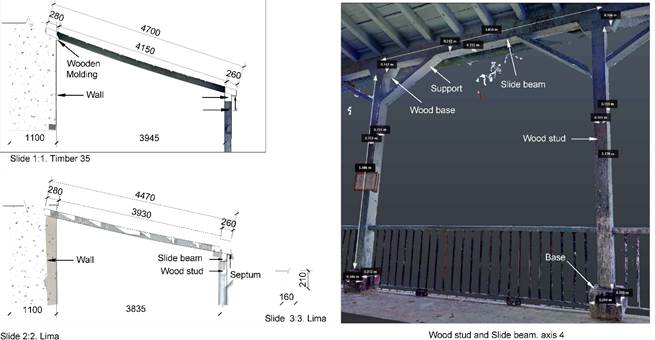 |
||||
| Figure 3. Dimensioning and deformation (in mm) of the wooden elements from the 3D models | ||||
| Table 2. General dimensions of the floor elements | ||||||||||||||
| Element | Base (cm) | Height (cm) | Spacing (cm) | |||||||||||
|---|---|---|---|---|---|---|---|---|---|---|---|---|---|---|
| Wood beam | 09-10 | 13 | 43-45 | |||||||||||
| Table | 45-48 | 18-24 | - | |||||||||||
| flashing | 45-48 | 05-06 | 31-38 | |||||||||||
| Lima | 16 | 21 | - | |||||||||||
| Slide beam | 15-16 | 21 | - | |||||||||||
| Wood base | 15-16 | 16-17 | - | |||||||||||
| Wood rest-food | 5 | 16 | - | |||||||||||
| Wood stud | 15-16 | 334-372 | 360-370 | |||||||||||
| Wood stud’s base | 30-40 | 27-30 | - | |||||||||||
For the structural analysis of the slab beams, orthoimages were extracted using the Reconstructor software, and cuts were made using the Autodesk Recap software from beam number 17 to 98. All the beams that make up the slab present deformations to a greater or lesser extent, and some show flexural failures due to a decrease in their bearing capacity. The Cuban standard (NC 53-179:88, 1988), establishes that the maximum admissible deflection is 1 240 of length for full load. This indicates that the admissible deflection for the wood beams is approximately 1.5 cm, but the values obtained on site are 2 cm to 4 cm higher than those acceptable by calculation. The standard establishes that the deflection of the beams will increase for load periods of more than 10 years by 50% for dry wood, and 100% for wet wood. Considering this, the allowable deflection would increase by 2.25 cm and 3.0 cm, respectively, for which there are still differences between allowable and actual values (Figure 4). It is important to note that not all the maximum deformations found are located in the center of the span, for the reason that there are areas where the element is more deteriorated than others; that is why the beams deform and fail in the most vulnerable area. It was identified that not all the beams are of the same wood species, which is why their hardness and resistance to bending also vary. In the right feet 1 and 7, the deterioration in the joints has caused the displacement of the same and of all the elements that adjoin it. These vertical movements that the right feet have suffered vary between 3.5 cm - 20 cm approximately, and the separation in the scarf joint between the beams that make up the sliding beam ranges between 1 cm to 2 cm, which represents considerable displacements.
To evaluate the deformation of the beams and the density they present, the identification of the timber species was carried out, from the taking of samples directly from the beams and uprights. The wood species were identified in a biological laboratory and the densities obtained with a penetrometer were compared with the reference values reported by the National Institute of Agro-Forest Research (INAF).
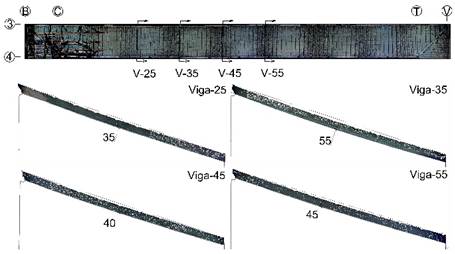 |
||||
| Figure 4. Deformations (in mm) of some wood beams | ||||
3.3 Identified timber species
Through the application of the comparative anatomy method from the histological sections made in transverse, tangential and radial directions, it was obtained as a result that the species of wood that form the structure of the roofing and the support system of the wood stud are: cedar (Cedrela odorata), pine (Pinus sp.), baría (Cordia gerascantus), caguairán (Guibourtia hymenifolia) and ácana (Manilkara grisebachii). Figure 5 shows the histological sections made to identify the existing wood species.
3.4 Analysis of diagnostic results
The moisture content measured in the floor beams is between 9%-19%, in the wood studs between 11%-17% and the sliding beam between 11%-12%. The thermographic images obtained reflected how the support wall presents areas of high humidity, which favors the absorption of water in the wood as it is a hygroscopic material.
In the case of the uprights and the sliding beam, the elements were partially wet because they are exposed to sunlight and their drying and ventilation conditions are more favorable than those of the wood beams. However, in times of rain and extreme weather events, this same exposure causes deterioration to be more accelerated and favors the proliferation and attack of wood-degrading organisms.
In the analysis with the thermographic camera, temperature changes of ±2ºC were identified at different points of the same element, which leads to thermal deformations of the roof. In the case of the beams, the coldest values are found near the boards and in the wall of axis 3, where the most considerable differences appear in the propped area and close to the floor. When it rains, the water infiltrates mainly through the areas where the waterproofing system is least preserved and where there is a greater presence of invasive plants, which causes the accumulation of water, both in the roof and in the wall. The degree of saturation of the wood elements varies depending on the species, the level of exposure and the environmental conditions, which leads to the triggering of pathological processes that weaken their mechanical properties. Other injuries identified with the thermography were temperature variations on the floor, associated with unevenness or damage that favor the accumulation of rainwater, and favor absorption by capillarity in the right feet of the gallery. Being embedded in a concrete base that works as a waterproof layer, drying inside the base is very inefficient and accelerates the decaying of the wood.
The analysis carried out with the resistograph allowed us to identify that of the 98 beams that make up the roof, 64 of them present different pathological manifestations associated with decay due to exposure to wetting and drying cycles. The resistography began in the area of the junction because it is the most vulnerable area, and depending on the damage detected, measurements were also made in the center of the span or near the supports (Figures 6 and 7).
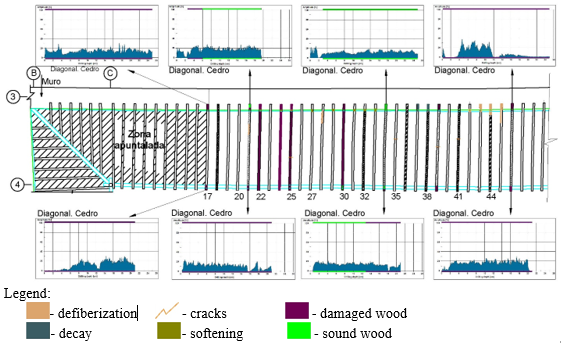 |
||||
| Figure 6. Results of resistography tests and damages in wooden elements between beams 1-49 | ||||
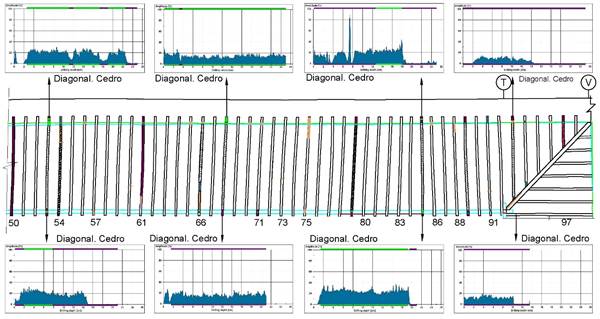 |
||||
| Figure 7. Results of resistography tests and damages in wooden elements between beams 50-98 | ||||
In the case of the wood studs, the resistography showed low penetration resistance values for all of them, and anomalies similar to those detected in the wooden beams. The extension of the lesions is between 150 mm and 750 mm from the concrete base upwards, and in more than 50% of the wood studs, it is located in the first 150 mm of height.
The sliding beam, with an extension of 45.5 m, is made up of sections, and each section of beams of different wood species. Due to the fact that the most vulnerable area is the exterior side, the resistography was carried out from the interior side (gallery) to the exterior (patio), with the purpose of identifying the progress in the deterioration based on the width of the beam. In the section between the wood studs 8 and 9, the resistography shows areas with defibration due to the attack of termites. These xylophagous organisms feed on the wood and leave tunnels inside it, consequently, the resistographic curve suddenly changes as a result of the lack of resistance during their advance (Figures 8 and 9). When carrying out the penetrometer tests and the corresponding adjustment calculations, it was evaluated that the wooden elements have a hardness lower than the tabulated values for Cuban woods. These results are in correspondence with the low resistances obtained in the resistography tests. Table 3 presents a sample of some of the elements studied.
| Table 3. Hardness calculation results from the penetrometer | |||||||||||||||||||
| Element | Location | Wood species | Moisture content (%) | Penetration 12% humidity (mm) | Calculated density 12% humidity (g/cm3) | Tabulated density 12% humidity* (g/cm3) | |||||||||||||
|---|---|---|---|---|---|---|---|---|---|---|---|---|---|---|---|---|---|---|---|
| Lima | axis 3 | Pine | 14 | 14 | 0.35 | 0.74 | |||||||||||||
| Beam 30 | axis 4 | Cedar | 13 | 17 | 0.27 | 0.37 | |||||||||||||
| Beam 50 | axis 3 | Cedar | 13 | 21 | 0.16 | 0.37 | |||||||||||||
| wood stud 8 | at 30 cm from base | Pine | 14 | 9.5 | 0.47 | 0.74 | |||||||||||||
| wood stud 9 | at 30 cm from base | Baría | 13 | 11 | 0.43 | 0.84 | |||||||||||||
| *- reference values provided by INAF | |||||||||||||||||||
3.5 Solution proposals
In the floor beams, it was determined that 17 of them need to be replaced as a result of their advanced deterioration. Additionally, another 45 beams must be structurally reinforced in different areas, depending on the pathologies developed in each one. Of the remaining 34 beams for which no significant injuries were identified, it will be necessary to disassemble and strip 2 of them due to superficial damages, in order to subsequently recalculate the load for the new beam section (Figures 10 and 11). All the wood studs showed deterioration that required structural reinforcement actions, as well as in the sliding beams, where it will be necessary to replace two sections and reinforce another 3 sections (Figures 12 and 13). The significant decrease in the density of the wood is the result of exposure to wetting and drying cycles, mainly in the rainy months, with the consequent proliferation of fungi and termite infestation. The deformations present in the beams are not only the result of the increase in weight due to excess water and the growth of higher plants, but also due to the loss of their timber properties, which increases the risk of structural failure.
 |
||||
| Figure 10. Proposal for a solution to the ceiling between beams 1-49 | ||||
 |
||||
| Figure 11. Proposal for a solution to the ceiling between beams 50-98 | ||||
 |
||||
| Figure 12. Proposal for a solution to the wood stud 1-7 and section of the sliding beam | ||||
 |
||||
| Figure 13. Proposal for a solution to the wood stud 8-13 and section of the sliding beam | ||||
4. Conclusion
The structure of the wooden ceiling of the gallery studied shows advanced deterioration, caused by reasons such as excess of moisture and the growth of invasive plants on the roof. This situation led to colonization by fungi and the attack of xylophagous organisms, which provoke losses in the properties of the wood used,
Applied density studies showed affectations in hardness as a result of exposure to wetting and drying cycles, and biological colonization. This had caused deformations in the beams and a decrease in the bearing capacity of the structural elements.
As a result of the diagnosis carried out, the need to replace 17 roof support beams and the structural reinforcement of another 45 was demonstrated. The wood stud must also be reinforced, while one of them will have to be replaced due to advanced deterioration, as well as some slide beam sections.
5. Aknowledgment
The authors wish to thank the OHCH Patrimonial Rehabilitation Investor Group for financing this research under contract No. S-5AI/2020 Ctto. 22DG/2019. It was carried out with the support of the Materials Division of the Tecnalia Research & Innovation Foundation under the FOCAD 2018 collaboration project.Likewise, we would like to thank the specialists and technicians of the Diagnostic and Survey Department for their participation, in particular the Engineers Rafael González Hernández and Dainelys Guerra Bouza for their considerable contribution, all the technicians from the Department of Diagnostic and Surveying, as well as to the Biologist Maider Arana of the Tecnalia Foundation in the elaboration of the termite control and eradication plan, and of the International Cooperation to Ing. Ingrid Alonso Esquivel.
References
Binda, A. (2009), Application of NDTs to the diagnosis of Historic Structures, Non-Destructive Testing in Civil Engineering, Nantes, France.
Guevara, J. L., Toirac, Y. A., Marisy, C. M. C. (2019), Un acercamiento al convento de Santa Clara de Asís de La Habana. Estudio de su estado de conservación y propuestas de intervención. Revista ALCONPAT, 9(2): 228-246. http://dx.doi.org/10.21041/ra.v9i2.354
Hasníková, H., Kuklík, P. (2014), Various non-destructive methods for investigation of timber members from a historical structure. Wood research, 59(3): 411-420.
Helal, J., Sofi, M., Mendis, P. (2015), Non-destructive testing of concrete: A review of methods. Electronic Journal of Structural Engineering, 14(1): 97-105.
Kherais, M., Csébfalvi, A., Len, A. (2021), The climate impact on timber structures. International journal of optimization in civil engineering, 11(1): 143-154.
Kloiber, M. (2007), "Ensayos no destructivos de las propiedades de la madera", Mendel University, Czech Republic, 208 pp.
Kuklík, P. (2007), Determinación de las propiedades estructurales de la madera, Praha.
Kumar, P., Imam, B.,(2013), Footprints of air pollution and changing environment on the sustainability of built infrastructure. Science of The Total Environment, 444: 85-101. http://dx.doi.org/10.1016/j.scitotenv.2012.11.056
Liñán, C. R., Conde, J. M., Hita, P. R. D., Gálvez, F .P. (2011), Inspección mediante técnicas no destructivas de un edificio histórico: oratorio San Felipe Neri (Cádiz). Informes de la Construcción, 63(521): 13-22. http://dx.doi.org/10.3989/ic.10.032
Morales-Conde, M. J., Rodríguez-Liñán, C., Rubio de Hita, P. (2013), Application of non-destructive techniques in the inspection of the wooden roof of historic buildings: A case study. Advanced Materials Research, 778: 233-242. http://10.4028/www.scientific.net/AMR.778.233
Norma Cubana (1988), NC 53-179:88 - Estructuras de madera. Método de cálculo. La Habana, Cuba.
Ortega, N. F., Ripani, M. (2007), Experiencias en el empleo de ensayos no destructivos, en el análisis de estructuras de hormigón afectadas por diferentes situaciones patológicas, IV Conferencia Panamericana de END Buenos Aires - Octubre 2007. Asociación Argentina de Ensayos no Destructivos y Estructurales (AAENDE), Argentina, pp. 1-12.
Ortiz, R., Fuentes, N., Jamet, A., Moya, A., González, M., Varela, M. P., Ramírez, A., Adofacci, G., Martínez, P. (2017), Evaluación resistográfica en elementos de maderas desfibradas de la torre de lixiviación de la oficina salitrera Santa Laura en Chile. Patrimonio de la Humanidad. Informes de la Construcción, 69(547): 1-6. http://dx.doi.org/10.3989/id54678
Palaia, L., Monfort, J., Sánchez, R., Gil, L., Álvarez, A., López, V., Tormo, S., Pérez, C., Navarro, P. (2008), "Assessment of timber structures in service, by using combined methods of non-destructive testing together with traditional ones". 9th International Conference on NDT of Art. Jerusalem, Israel.
Sesana, E., Gagnon, A. S., Ciantelli, C., Cassar, J., Hughes, J. J. (2021), Climate change impacts on cultural heritage: A literature review. Wiley Interdisciplinary Reviews: Climate Change: e710. https://doi.org/10.1002/wcc.710
Tucci, G., Bonora, V. (2017), Towers in San Gimignano: metric survey approach. Journal of performance of constructed facilities, 31(6). http://doi.org/10.1061/(ASCE)CF.1943-5509.0001085
Workman, G. L., Moore, P. O. (2012), "Nondestructive Testing Handbook 10: Overview". American Society for Nondestructive Testing.

